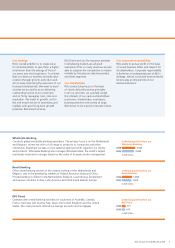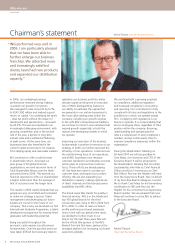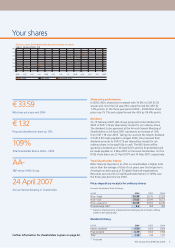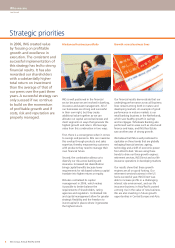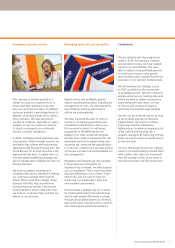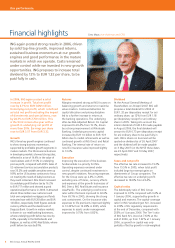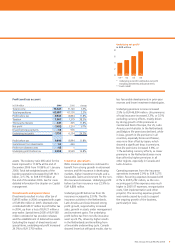ING Direct 2006 Annual Report Download - page 15
Download and view the complete annual report
Please find page 15 of the 2006 ING Direct annual report below. You can navigate through the pages in the report by either clicking on the pages listed below, or by using the keyword search tool below to find specific information within the annual report.
Compliance
In line with recent United States securities law,
ING provided a statement for the fi rst time on
the effectiveness of internal controls over the
company’s fi nancial reporting, the so-called
SOX 404 statement. All CEOs and CFOs of
companies listed on the New York Stock
Exchange must now provide the statement
on an annual basis, as required by the US
corporate regulator, the Securities Exchange
Commission (SEC), following the enactment of
the Sarbanes-Oxley Act (SOX) of 2002.
exposure to market risk in line with the
Executive Board’s risk appetite.
Value-at-Risk
One of our primary market risk measures
is Value-at-Risk (VaR), on which limits
are based. VaR quantifi es the maximum
overnight loss that could occur due to
changes in risk factors if positions remain
unchanged for one day (at 99% confi dence
level). Average consolidated VaR over 2006
for the trading book was EUR 31 million
(2005: EUR 28 million). Trading positions
with interest rate exposures provided the
largest contribution to the trading VaR
and was the main driver of the EUR 3
million increase. In addition, we perform
stress testing to monitor market risk under
extreme market movements.
Average consolidated foreign exchange
VaR over 2006 for the non-trading activities
was EUR 17 million (2005: EUR 7 million).
The increase was due to expanded activities
of ING Direct in Australia and Canada.
Consequently, the Australian and Canadian
dollar are added to the list of main
currencies that are held to protect the
Tier-1 ratio against currency movements.
Interest rate risk
Due to the strategic interest rate risk
mismatch in the non-trading books ING
Bank is sensitive to interest rate changes.
To measure this, ING Bank calculates
Earnings-at-Risk (EaR) and VaR. EaR
measures the loss of net accrual interest
income over a period of one year resulting
from, amongst other factors,
an instantaneous increase in market interest
rates. Applying a 1% shock to year-end
market rates resulted in an EaR of EUR -364
million. EaR calculations have changed to
better align with accounting rules and now
capture the effect of embedded prepayment
and offered rate options of the large Dutch
mortgage portfolios.
Liquidity risk
ING Bank also manages its liquidity risk.
In 2006, we continued to have a sound
liquidity profi le since a large liquidity buffer
is maintained against unexpected negative
market developments.
ING Insurance risk
ING Insurance is engaged in selling life
and non-life insurance products. Risks
arising from these products are classifi ed
as actuarial and underwriting risk, market
risk, credit risk (as described previously)
and operational risk.
Actuarial and underwriting risks are
the risks resulting from the pricing and
acceptance of insurance contracts. ING
primarily manages these risks through
policies, product design requirements,
independent product approval processes
and risk limitation related to insurance
policy terms and conditions with the client.
Profi t & loss volatility stemming from
adverse claims in ING’s insurance portfolios
is managed by setting insurance risk
tolerance levels.
ING Insurance is exposed to market risks:
the risk that changes in interest rates, equity
prices, foreign exchange rates and real
estate prices affect its present and future
earnings as well as shareholders’ equity.
Interest rate risk
ING Insurance measures potential changes
in the expected earnings of insurance
activities over a period of one year resulting
from an instantaneous increase/decrease
of 1% in interest rates. As at 31 December
2006, the impact on net profi t of a 1%
point increase/decrease was estimated at
EUR 8/-1,600 million (2005: EUR -68/
-1,743 million).
Equity risk
The impact of equity risk on net profi t is
measured under a scenario in which an
instantaneous increase/decrease of 10% in
equity markets occurs. As at 31 December
2006, the impact of a 10% increase was
estimated at EUR 120 million, while the
impact of a 10% decrease was estimated
at EUR -150 million.
Operational, information and
security risk
Operational risk arises from direct or
indirect loss resulting from inadequate
or failed internal processes, people and
systems or from external events. ING has
developed a sophisticated framework
for assessing, monitoring and managing
operational, information and security risk.
This framework was improved in 2006
by further implementation of ING Group
operational, information and security risk
management policies, by strengthening the
security organisation and by increasing risk
and security awareness.
Risk classes bank and insurance
portfolios
2006
as % of total outstandings Bank Insurance
1 (AAA) 13.6% 25.1%
2-4 (AA) 20.6% 22.6%
5-7 (A) 10.9% 22.0%
8-10 (BBB) 21.3% 15.8%
11-13 (BB) 27.6% 10.3%
14-17 (B) 4.1% 4.0%
18-22 (Watch/Problem grade) 1.9% 0.2%
100% 100%
ING Group Annual Review 2006 13


